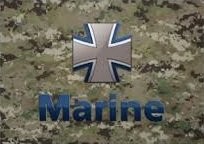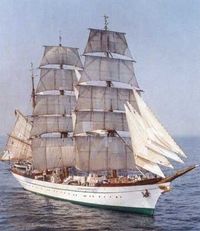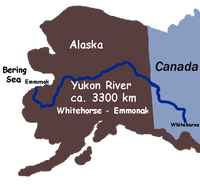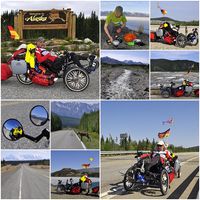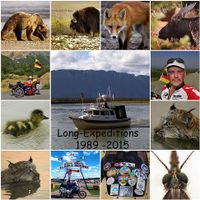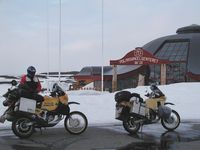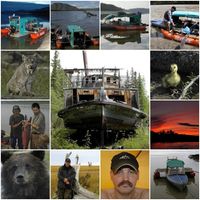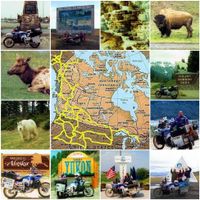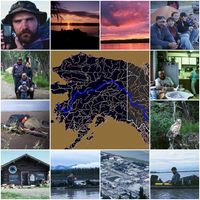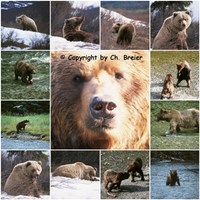The Mackenzie River is the longest river in Canada, the second longest in North America, and one of the ten longest rivers in the world. The river drains a basin of approximately 1.8 million km2 in central Canada and has a total length of 4210 km.
Its delta can be classified as an arctic delta; it is ice-free for approximately 3 to 4 months a year
Canada's longest river, the Mackenzie River, empties into the cold Beaufort Sea in a region known as the Mackenzie Delta. Sediments laid down by the river over the past 7000 years have created a vast delta 13,500 km2 in area. Diverse populations of birds and fish and several northern communities call this complex and dynamic mixture of lakes, rivers and flood plains home. Sub arctic in location, permafrost plays a dominant role in the formation of the delta. Situated above 67.5 degrees N., the majority of the delta still remains in the discontinuous permafrost zone. This is due to the warming of the landscape caused by the Mackenzie River. The unfrozen, nutrient rich soil allows treeline to reach farther north in the Western Arctic than elsewhere in the NWT. In the northern part of the delta, near Tuktoyaktuk where the permafrost is continuous, the world’s largest concentration of pingos (cone-shaped hills with a core of ice) are found dotting the landscape. Two types of vegetation dominate the plant communities of the delta, tundra along the Beaufort Sea and taiga further inland. Successional changes in some plant communities are maintained by seasonal flooding and by fire. This transitional zone provides a home for a variety of wildlife not normally seen at these latitudes.
In warmer climates deltas are usually prime agricultural land. In the North, however, productivity is expressed instead in seasonal abundance of various forms of wildlife. Many of these wildlife species are migratory and also play an important role in the traditional lives of peoples living in and around the delta. Approximately fifty-four species of mammals, one hundred and thirty-seven species of birds, one amphibian, and a total of fifty-five fish species are known to occur in the delta region
Beagles for breakfast
Point Separation - About 24 kilometres downstream from Arctic Red River, the Mackenzie splits up into the channels and streams of the Mackenzie Delta. We are so lucky, a nother calm day as we enter the Mackenzie delta
ORCA under way
An old cabin in the Aklavik Channel
We can see the Richartson Mtn.
Every thing is turning into colors..
Near Aklavik
ORCA at Aklavik
The harbor of Aklavik
Aklavik is located on the Peel channel of the Mackenzie River Delta 113 km south of the Arctic Coast. There is no summer road access, however, in winter, an ice road stretches across the Mackenzie Delta to Inuvik.
Aklavik is a community of some 750 Gwich'in and Inuvialuit, many of whom still harvest fish and muskrats. Traditionally, Gwich'in and Inuvialuit gathered here to trade for goods from as far away as the Pacific and Arctic coasts. The Hudson's Bay Company set up a post across the channel in 1912 to trade for furs. By 1918, Aklavik was a permanent settlement and the centre of a thriving trapping economy based on local muskrats and white fox from the Arctic.
The Anglican mission was set up in 1919, and Aklavik became the headquarters for the RCMP in the western Arctic in 1922. The Roman Catholic mission was established in 1926. Mission hospitals and residential schools attracted people from the surrounding region, and by 1952, some 1500 people, as well as government services, were based in Aklavik.
Serious flooding and erosion of Aklavik's island townsite caused an attempt to move the community. Inuvik was built by government some 58 km west, and in 1961, the new town was ready. Although most services were moved, many residents decided to remain in Aklavik.
The Mad Trapper sign
THE MAD TRAPPER OF RAT RIVER
On July 9, 1931 Albert Johnson arrived in Fort MacPherson in the Northwest Territories of Canada. He was a mysterious man who built an 8x10 cabin by the Rat River and lived in it without a trapping license. The fact that he never bought a trapping license seemed odd to the inhabitants of the area because his cabin was in prime trapping territory. During the early winter of that same year other trappers began to complain of evidence that someone had been tampering with their traps.
On December 31, 1931 two officers of the Royal Canadian Mounted Police went to visit and question Albert Johnson about the possibility that he could be the one messing with the traps. However he ignored them and shut all of the blinds pretending that he did not notice them. They returned two days later with a warrant to search the house and when he did not answer they took advantage of the warrant and forced entrance. The first officer to enter the house Johnson shot and they were required to return to the town for the officer to receive medical attention.
A new group was formed consisting of 9 men, 42 dogs, and 20 pounds of dynamite (Yukon Territory). The group proceeded to blow up Johnson’s cabin with the dynamite expecting him to be injured or killed with the explosion. When they went in to the cabin to retrieve Johnson, or whatever was left of him, he shot at them from a fox hole that he had dug under his cabin. Once again they were forced to return to town for further instruction. On January 14, 1932 the men returned to Johnson’s Cabin and he was gone.
On January 30th they caught up with him by tracking and he shot a constable through the heart. The other Mounties held their ground, however that night he escaped down a cliff. His disappearance resulted in a 150 mile, 48 day long manhunt. The Mounties were forced to ask for help from local native people and a pilot to search for Johnson. The pilot discovered that he had been following the caribou tracks along the middle of the river during the day and sleeping in the woods surrounding the river at night. With this discovery the Mounties were able to catch up with him around February 5th. Another shoot out took place and Johnson finally died after being shot nine times.
Me at the Grave of the Mad Trapper, 2 weeks befor we arrived they exhumated the Mad Trapper to get some DNA samples to solve his real identity.
Hey, at least some flowers on the grave after that would be nice.
We where honored to be guest at Philip & Lorianne Elanik. With some friends they show us the drumming and dancing. Thank you very much to all of you ! ! !
The drumming was very nice
Everybody had fun...
Good to see the youth maintaining there traditions !
I did a lot of filming....
After some hours of filming out of hand, my camera was getting really heavy..
Thanks for your northern hospitality !
Some Swans
There are a lot of camps in the east Channel
Orca in the East Channel
I did not expect that in the east channel to Inuvik
We where very lucky that the water was so low, otherwise we had no chance to avoid that Rock...
ORCA at Inuvik
The Coast Guard Ship DUMIT in Inuvik
Sundown at Inuvik
Inuvik by Night!
Next: Bering Sea
Only those who risk going too far, will discover how far they can go!
Expedition in USA, Alaska & Canada, Scandinavia with folding boat, motorboat, catamaran, motorcycle, off-road vehicle, bicycle ...































